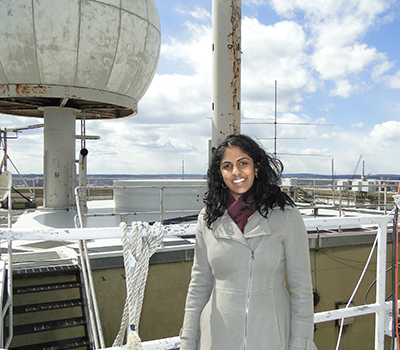
In November 2011, Anita Ganesan travelled to the foothills of the Himalayas to the small, remote village of Darjeeling, India. Her goal: to fill the hole of missing greenhouse gas data.
“People can say they are for or against something, but because of uncertainties in climate science, it is more nuanced,” says Ganesan, who recently completed her Ph.D. “But the more measurements there are, the more data we have, the better we’ll be able to reduce uncertainties. That’s what I wanted to achieve as I set out to fill in some of the gaps in this important region of the world.”
With the support and encouragement of her thesis advisor and Joint Program Co-Director, Ron Prinn, Ganesan built and set up an air monitoring instrument in Darjeeling that has been feeding her valuable information about the composition of the atmosphere every 10 minutes for now over a year. Specifically, Ganesan designed the device to report the concentrations of some of the most potent greenhouse gases —methane, nitrous oxide and sulfur hexafluoride.
Ganesan’s location was strategic. A strong monsoonal flow allows her to detect the pollution from across India. At the same time, Darjeeling borders Nepal, Bhutan and Bangladesh, so Ganesan can gather data from parts of South Asia.
The hope, Ganesan says, is that her station will become fully integrated into a greater network created and overseen by Prinn—the Advanced Global Atmospheric Gases Experiment (AGAGE). Through AGAGE, Prinn and a team of researchers from around the world have been measuring the composition of the global atmosphere since 1978. This observational data has helped to refine and improve climate change research for the past three decades.
“There are very few measurements being made in the developing world,” Ganesan says. “I see this station in Darjeeling as a starting point. Given India’s role as a significant player in the global economy, it’s important that we continue this effort.”Like other researchers collecting atmospheric measurements, Ganesan is using the data and backtracking to figure out where the emissions originate. This inverse method allows her and her colleagues to determine how emissions are changing over time—reducing uncertainty in each region where measurements are being made.
Ganesan’s inverse modeling finds, not surprisingly, that methane and nitrous oxide are coming largely from India’s agricultural industry— namely rice paddies, cattle and fertilizers.
“Now that we have a better idea of the level of emissions and where they’re coming from, the next step is obviously what are we going to do about it?” Ganesan says. “That’s a much more difficult question to answer in some ways because it’s really integrated with the human factor, and specifically India’s food system. This is something that a lot of scientists are working on—finding ways to improve farming practices to minimize emissions of methane and nitrous oxide, while preserving crop yields.”
Thinking about the bigger picture is something Ganesan has been trained to do, having worked closely with Prinn and the Joint Program.
“This ability to integrate the science and the policy is something that I don’t think exists everywhere,” Ganesan says. “Having not known much about the economic side before coming to MIT, I’ve been able to learn from others and that’s been really important because it affects everything I study. It was an opportunity I don’t think I would have gotten anywhere else.”
She also credits Prinn for giving her the freedom to take the project in the direction she chose, and her colleagues in the Department of Earth, Atmospheric and Planetary Sciences for their support.
“Because everyone is really hard working, it’s a good environment to do an ambitious project because everyone around you is also so motivated that it gives you a little bit of fuel,” says Ganesan, “It will be difficult to leave.”
She won’t have to leave just yet. Ganesan has started postdoctoral research with Prinn and will continue her work with the Indian government and collaborators to make the monitoring station an official part of the AGAGE network.

